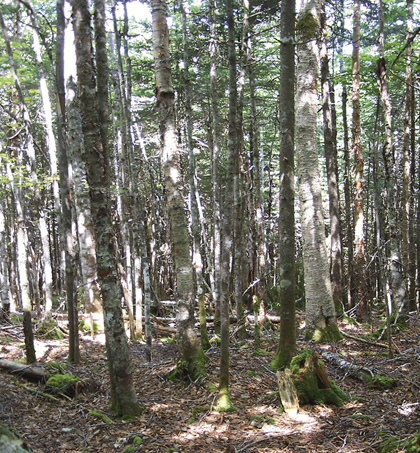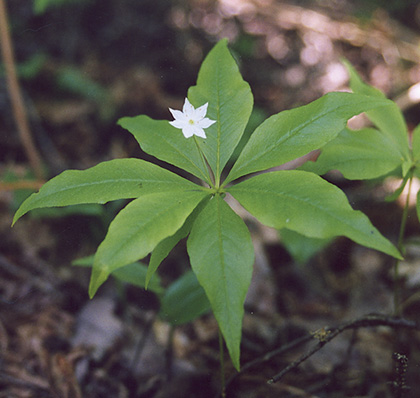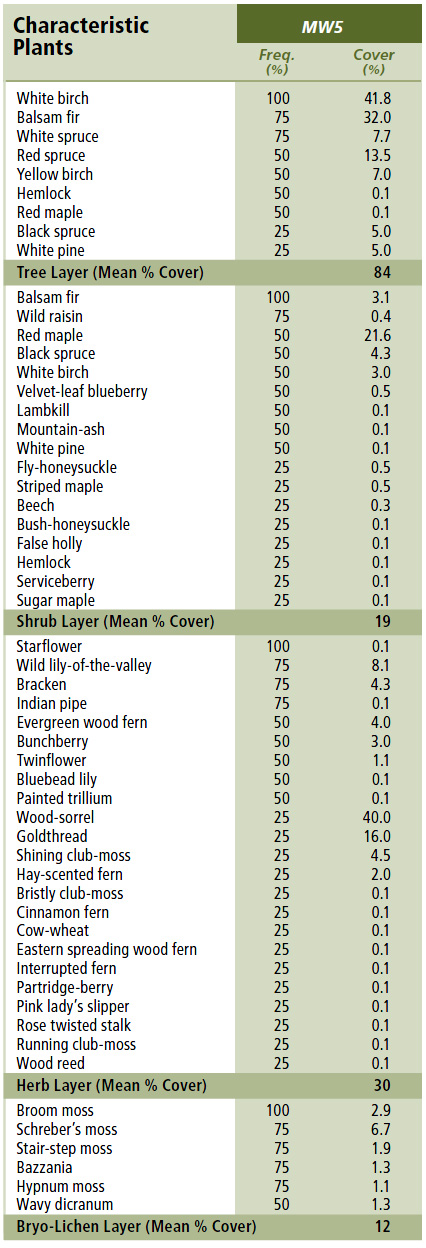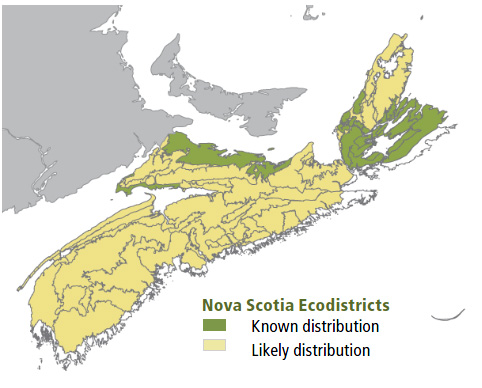
Forest Vegetation types - MW5
MW5 — White birch – Balsam fir / Starflower
Betula papyrifera – Abies balsamea / Trientalis borealis
 |
Fox River, Cumberland County |
Concept: This early successional mixedwood Vegetation Type (VT) has an overstory co-dominated by white birch and balsam fir. Various other trees may have a minor presence. MW5 is a broadly defined VT that follows stand-replacing disturbance events such as windthrow or harvesting. Residual trees (survivors of past disturbance events) should not be used for classifying this VT from others. Due to the short-lived nature of balsam fir, this VT often supports significant levels of coarse wood debris and/or numerous snags. White birch – Balsam fir / Starflower is commonly found VT in eastern Nova Scotia.
Vegetation: White birch and balsam fir are the dominant overstory trees, with lesser red spruce, yellow birch, white spruce and/or red maple. Minor amounts of black spruce, hemlock and white pine can also be found on some sites. The shrub layer is moderately developed and dominated by regenerating trees (especially balsam fir and red maple). The herb layer is represented by typical forest flora including wild lily-of-the-valley, starflower, bluebead lily, goldthread and wood sorrel. Bracken, hay-scented fern and cinnamon fern can also be found – their presence and relative abundance reflecting available moisture. Bryophyte development varies; its coverage directly related to softwood overstory abundance. Schreber's moss, stair-step moss and broom moss are the main species. Bazzania can also be common where coarse woody debris has accumulated on the forest floor.
Environmental Setting: MW5 is mainly associated with fresh to moist, nutrient-medium soils of variable texture. This VT has not been well sampled but appears to occur throughout eastern Nova Scotia and is scattered elsewhere. It is common in New Brunswick and Prince Edward Island.
Successional Dynamics: MW5 is an early successional VT dominated by white birch and balsam fir. It is an even-aged VT that usually follows stand-level disturbances such as windthrow and harvesting. As the short-lived and shade-intolerant white birch starts to lose overstory dominance, other mid and late successional VTs can develop including SH5 (Red spruce – Balsam fir / Schreber's moss), SH6 (Red spruce – Balsam fir / Stair-step moss – Sphagnum) and SH8 (Balsam fir /Wood fern / Schreber's moss). Residuals in the overstory can provide evidence of pre-disturbance conditions and should be considered when assessing possible successional trends.
Ecological Features:This closed canopy patch forest typically follows stand-level disturbances such as harvesting. Regeneration is by seed or coppice. This ecosystem provides several ecological functions including the facilitation of nutrient cycling, rapid site revegetation after disturbance, and the establishment of nurse crops for later successional species such as red spruce, hemlock and yellow birch. Residual trees from early successional stages are common and may provide notable wildlife habitat values and increased forest structural complexity. Mixedwood forests provide both shelter and food for overwintering deer. Sapling stage occurrences may provide browsing habitat for snowshoe hare, deer and moose.
 |
| Starflower |
Distinguishing Features: This mixedwood forest of balsam fir and white birch establishes after a stand-level disturbance. The herbaceous layer is generally comprised of common woodland plants such as wild lily-of-the-valley, starflower, bluebead lily, goldthread and wood sorrel.
| Slope Position: | Middle5 Upper5 |
Surface Stoniness: |
(Non - Slightly)8 (Very - Excessively)2 |
Bedrock Outcrop: |
(Non-rocky)10 |
Elevation Range: |
83 - 144m |
Slope Gradient: |
Gentle8 Steep2 |
Aspect: |
East3 South4 West3 |
Exposure: |
Moderate5 Mod. exposed5 |
Microtopography: |
Moderately6 Slightly2 Strongly2 |
Drainage: |
Well8 Moderately well2 |
Soil Type: |
ST26 ST12 ST62 |
Parent Material: |
Glacial till8 Colluvium2 |
Rooting Depth (cm): |
(30-45)6 (>45)2 nd2 |
Duff Thickness (cm): |
(6-10)8 nd2 |

